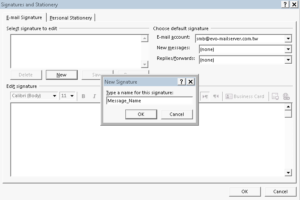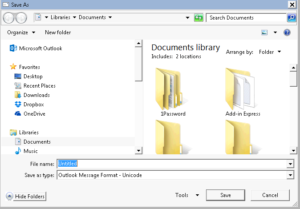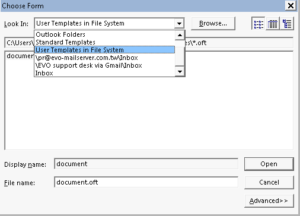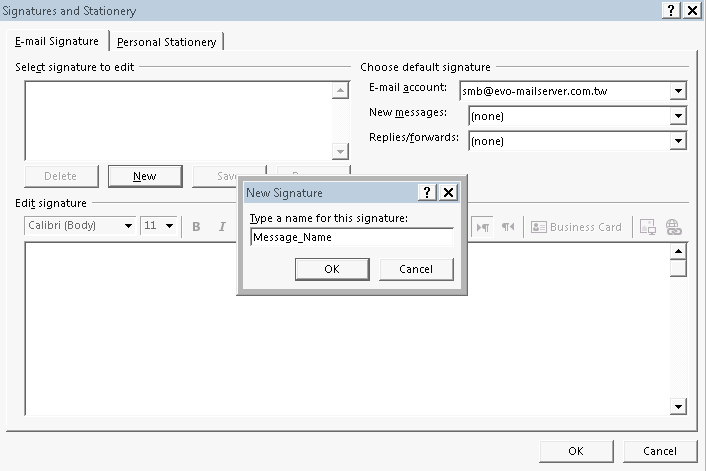Better ways than copy & paste to compose mails of the same content
At work, we send many emails with similar content throughout the day. We can type them again and again or we find email previously written and copy & paste. Another method is to keep a copy in draft folder or another sub-folder where you can retrieve it later, but it is hard to maintain. Overall, none of them is efficient.
There are several ways to deal with this issue to save time:
- Use Signature feature for composing a new message or replying a message:
- Click on New Email or Reply or Forward buttons.
- Click on Signatures at the top.
- Click on New to create a name compose messages.

- Select message from pull-down list of New Messages or Replies/forwards.

- Click OK to save.
- Click on Signatures again and select the saved signature.

- Pros:
- Easy to create simple templates with images as well as fonts in different type and size.
- A simple list of templates can be selected by clicking on Signature from top menu.
- Free of charge.
- Cons:
- Unable to insert variable headers within mail such as recipient, sender, and etc.
- Unable to share with other colleagues who need templates of the same kind.
- Cannot sort templates accordingly.
- Use Outlook Template (OFT) for composing a new message:
- Click on New Email button to compose a message which you want to use.
- When finishing composition, click on FILE -> Save As.
- Select Outlook Template from Save as Type pull-down list.

- When you want to use the Outlook Template to send messages, click on New Items -> More Items -> Choose Forms.

- Select User Templates in File System from Look In pull-down list.

- Choose a template you want to use and click on Open.
- Pros:
- Easy to create simple templates with images as well as fonts in different type and size.
- Free of charge.
- Shareable with other colleagues who need templates of the same kind via copying templates to a networked drive, Dropbox or OneDrive.
- Cons:
- Unable to insert variable headers within mail such as recipient, sender, and etc.
- Need to manually create folders in hierarchical structure to sort templates accordingly in Windows Explorer.
- Templates can only be used when writing a new e-mail and cannot be used on replying e-mails.
- Use third-party Outlook add-in:
- Quick Templates for Outlook & Template Phrases for Microsoft Outlook – These two add-ins work in similar fashion to help you to manage templates that you create during mail composition or that you prepare ahead of time.
- Tutorial video: Ablebits’s Template Phrases
- Pros:
- Easy to create simple templates with images as well as fonts in different type and size in a built-in template editor.
- Templates are listed in a hierarchical structure for easy and instinctive lookup.
- With sharing templates on networked drives, colleagues across a company benefit from manually updated version of the same template.
- Being able to insert variable headers within mail such as recipient, sender, and etc via macros.
- Cons:
- Not free: Cost of $29.95 for Template Phrases for Microsoft Outlook.
- Though shareable, it cannot sync automatically. Users need to manually import and export templates. Yet, duplicates of the same templates are created each time import takes place.
- The above situation also applies when you use Dropbox or OneDrive.
- Pros:
- Tutorial video: MAPILab’s Quick Templates for Outlook
- Pros:
- Easy to create simple templates with images as well as fonts in different type and size in a New Mail editor or other template editor.
- Shareable with other colleagues who need templates of the same kind through networked drive.
- Templates are stored in categories.
- Being able to insert variable headers within mail such as recipient, sender, and etc via macros.
- Cons:
- Not free: $24.00 for Quick Templates for Outlook.
- Template management GUI is poorly designed on Edit window or not being descriptive enough.
- I tried out both Outlook 2013 and 2016, Outlook 2016 works fine but Outlook 2013 seems having trouble even creating a template from scratch:

- In Outlook 2013, after I manually copy database file from other computer, template list shows. But, when I select any of the templates, an error pops up:

- For MAPILab’s Quick Template for Outlook, it seems to have trouble with updating changes made locally to Dropbox. After I observe Dropbox’s file status reminder, a Quick Template’s cache file was deleted a few seconds after change was made.
 Due to the cache was gone almost instantaneously, Dropbox and other remote computers synchronizing with the same Dropbox account were not able to catch the change. Thus, MAPILab’s Outlook Template for Outlook failed to be shared via cloud storage such as Dropbox and OneDrive.
Due to the cache was gone almost instantaneously, Dropbox and other remote computers synchronizing with the same Dropbox account were not able to catch the change. Thus, MAPILab’s Outlook Template for Outlook failed to be shared via cloud storage such as Dropbox and OneDrive. - Tech support and tutorial video do not give more details on extensive usages. I encounter several issues described as above and tried to find on MAPILab’s website but failed.
- Pros:

